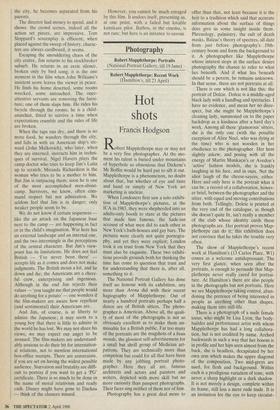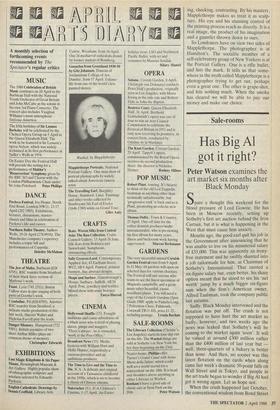Photography
Robert Mapplethorpe: Portraits (National Portrait Gallery, till 19 June)
Hot shots
Francis Hodgson
Robert Mapplethorpe may or may not be a very fine photographer. At the mo- ment his talent is buried under mountains of hyperbole so obnoxious that Dickens's Mr Boffin would be hard put to sift it out. Mapplethorpe is a phenomenon, no doubt about that, but whether, of eye and taste and hand or simply of New York art marketing is unclear.
When Londoners first saw a solo exhibi- tion of Mapplethorpe's pictures, at the ICA in 1983, they were shepherded into an adults-only booth to stare at the pictures that made him famous, the Sade-ian account of what men did to each other in New York's bath-houses and gay bars. The pictures were clearly not quite pornogra- phy, and yet they were explicit; London took it on trust from New York that they must also be exquisite. These two exhibi- tions provide grounds both for thinking the time has come to question that trust and for understanding that there is, after all, something to it.
The National Portrait Gallery has done itself no honour with its exhibition, any more than Arena did with their recent hagiography of Mapplethorpe. Out of nearly a hundred portraits perhaps half a dozen are of British sitters. The photo- grapher is American. Above all, the quali- ty of most of the photographs is not so obviously excellent as to make them un- missable for a British public. Far too many of the portraits are the mugshots of a beau monde, the glossiest self-advertisement for a small but shrill group of Medician art- patrons. They are technically more than competent but could for all that have been made by any jobbing portrait photo- grapher. Here they all are, famous architects and actors and painters and writers, depicted with more skill but no more curiosity than passport photographs. Their faces sing neither of them nor of him.
Photography has a great deal more to offer than that, not least because it is the heir to a tradition which said that accurate information about the surface of things does give us some insight inside them. Phrenology, palmistry, the cult of death masks, Balzac's theory of spectres, all date from just before photography's 19th- century boom and form the background to it. A photographer like Mapplethorpe whose interest stops at the surface denies photography the chance to refer to what lies beneath. And if what lies beneath should be a person, he remains unknown. In that sense, these are not portraits at all.
There is one which is not like this: the portrait of Dolcie. Dolcie is a middle-aged black lady with a handbag and spectacles. I have no evidence, and mean her no disre- spect, but she might be Mapplethorpe's cleaning lady, summoned on to the paper backdrop as a kindness after a hard day's work. Among all these 'glamorous' sitters, she is the only one (with the possible exception of Alice Neel, who was dying at the time) who is not wooden in her obedience to the photographer. Her hem slightly askew, and posing with all the energy of Martin Munkacsi's or Avedon's 'active' fashion models, she is frankly laughing in his face, and in ours. Not the idiot laugh of the cheese-sayers, either. Here and only here is the portrait what it can be, a record of a collaboration, howev- er brief, between the photographer and the sitter, with equal and moving contributions from both. Tellingly, Dolcie is printed at the very end of the catalogue, as though she doesn't quite fit, isn't really a member of the club whose identity cards these photographs are. Her portrait proves Map- plethorpe can do it; this exhibition does not convince that he takes the trouble very often.
The show of MapplethOrpe's recent work at Hamilton's (13 Carlos Place, W1) comes as a welcome antidepressant. The very first glance, when seen after the portraits, is enough to persuade that Map- plethorpe never really cared for portrai- ture. At Hamilton's there are also people in the photographs but not portraits. Here we see Mapplethorpe taking control, aban- doning the pretence of being interested in people as anything other than shapes, making them into still-life.
There is a photograph of a nude female torso, who might be Lisa Lyon, the body- builder and performance artist with whom Mapplethorpe has had a long collabora- tion, but is not credited by name. Arched backwards in such a way that her bosom is in profile and her hips seen almost from the back, she is headless, decapitated by her own arm which makes the upper diagonal of the composition. Two mid-greys are used, for flesh and background. Within each is a prodigious variation of tone, with never a sharp highlight or a dark shadow. It is not merely a design, complete within its frame, still less a mere rude nude. It is an invitation for the eye to keep circulat- ing, checking, contrasting. By his mastery, Mapplethorpe makes us treat it as sculp- ture. His eye and his stunning control of the printing process reach us directly. It is a real image, the product of his imagination and a gauntlet thrown down to ours.
So Londoners have on view two sides of Mapplethorpe. The photographer is at Hamilton's. The socialite member of a self-celebratory group of New Yorkers is at the Portrait Gallery. One is a rifle bullet. and hits the mark. It tells us that some- where in the myth called Mapplethorpe is a photographer trying to get out, perhaps even a great one. The other is grape-shot, and hits nothing much. When the smoke has cleared we will be able to pay our money and make our choice.



















































 Previous page
Previous page